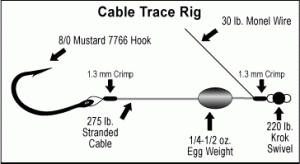Pro Angles Offshore – Capt. Rick Croson
A familiar conundrum faces NC blue water anglers as the Gulf Stream seasons shift. Should they be running wire leaders on ballyhoo rigs to protect against bite-offs from wahoo, king mackerel, and other toothy predators, or should they run mono/fluorocarbon rigs in the hopes of attracting and drawing bites from line-shy tuna and billfish?
Wilmington Capt. Rick Croson, of Living Waters Guide Service, came up with an answer a few years back, a rig that offers protection from the tooth and scale gang while retaining the low-visibility of a mono or fluorocarbon leader.
“It’s called the cable trace rig,” Croson explains. “I designed the rig about seven years ago as a way to have mono out at all times and still have some protection from wahoo and king mackerel. All the cable ends up inside the bait, so you can run mono or fluoro leaders without vulnerability.”
The rig consists of a 3” piece of 275 lb. stranded cable, an angler’s preferred hook (Croson likes a Mustad 7766 8/0 for medium ballyhoo), a length of 30 lb. monel wire, a pair of 1.3 mm crimps, a 1/4-1/2 oz. egg weight, and a barrel swivel.
“I like a stainless Krok 220 lb. swivel,” Croson reveals. “You don’t want a ball-bearing swivel because you don’t want the rig spinning on its own. And with the Krok swivel and a stainless hook, the entire rig is stainless, so it’s reusable as long as you can keep it.”
With the hook crimped at one end of the cable, the swivel and monel wire at the other, and the egg weight sliding between, anglers have a rig that offers more benefits than simply sneakily “tooth-proofing” the rig.
“One of the great things about the rig is that it’s adjustable,” Croson says. “It’s not a pin rig, so you can slide the weight up and down so it fits different sized ballyhoo. You know how you buy a dozen medium ballyhoo and two or three are always too big or small for a normal rig? This lets you rig all of them.”
When run with a skirt, the ballyhoo that ends up on the rig also swims better than those on a conventional rig, wire or mono.
Croson explains, “The skirt doesn’t sit on the head of the bait because of the swivel. That small gap lets the ballyhoo swim on its own behalf without the skirt interfering.”
Anglers can use the cable trace rigs with conventional or wind-on style leaders.
“The rig itself,” notes Croson, “is independent of the leader.”
An advantage of the rig in conjunction with a wind-on leader is that anglers can catch a fish, slide the skirt up the leader and cut the rig off, and re-crimp a new cable trace on without having to set up a whole new leader.
“On a standard 8-10’ leader with a snap-swivel, you can just unsnap it, snap a new one on, and keep fishing. And when you get the rig out of the fish, the ballyhoo part of the rig is still perfect and ready to go,” Croson says.
Aside from countless wahoo, tuna, and dolphin, the cable trace rig has proved itself worthy of our area’s top predator as well.
“It’s caught pretty much all species,” Croson explains. “We released a 600 lb. blue marlin on one a few years ago that we’d never have caught on a normal rig. We were using 130 fluorocarbon leaders, but the cable was rubbing on that fish’s bill the whole fight. There’s no way the 130 would have lasted that long.”

